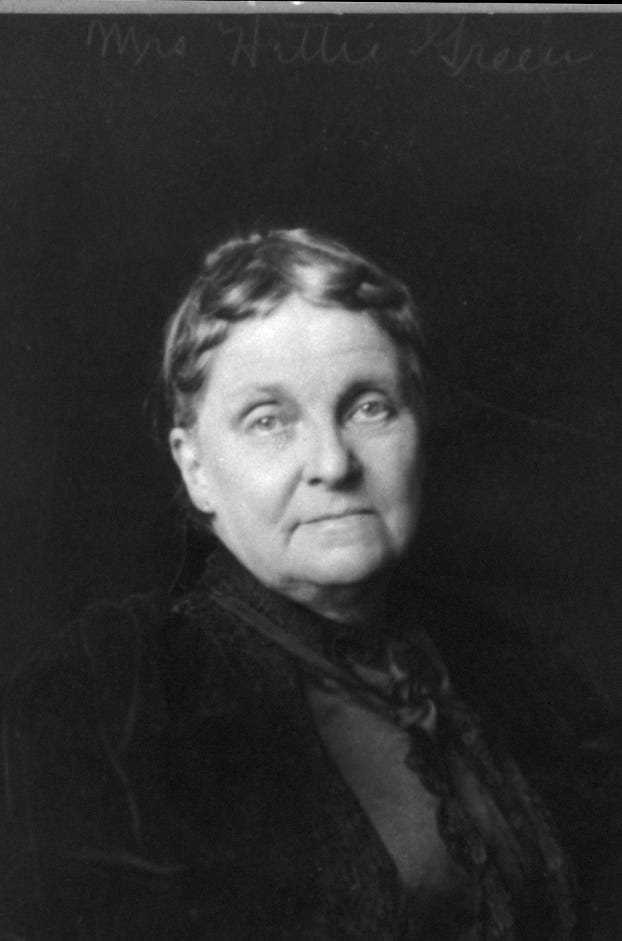Hetty Green: Repairing the Legacy of an Exceptional Mother
If a man had lived as did Hetty Green…nobody would have seen him as very peculiar…It was the fact that Mrs. Green was a woman that made her career the subject of endless curiosity, comment, and astonishment…Though something of hardness was ascribed to her, that she harmed any is not recorded, and victims of ruthlessness are usually audible…That there are few like her is not a cause of regret; that there are many less commendable, is one.”
New York Times (July 5, 1916)
I must begin by offering a big shout out to Mary Carlson for sharing an article published today in the Washington Post. The article grossly mischaracterizes Hetty Green as one of history’s worst moms, which could not be further from the truth. In several past newsletters, I have expressed my admiration for Hetty Green, who I regard as the greatest investor in U.S. history. The Winter 2022 issue of the American Museum of Finance’s Financial History magazine revisits her extraordinary accomplishments, which were made all the more impressive by the fact that she had none of the advantages afforded to her male contemporaries. My hope is that this newsletter continues to reform her legacy — not only as an investor, but also as a mother.
The story in the Washington Post is based on an alleged incident in which Hetty Green sought treatment for her son’s injured leg to avoid amputation. Hetty allegedly presented herself as a charity patient, which would allow Ned to obtain treatment for free. In fairness, this was a morally questionable form of thrift, but it does not reflect Hetty’s character as a mother. Ned Green had injured his leg while sledding several years before the incident, and Hetty spent years consulting with (and paying) the best physicians. She also treated him with every home remedy she could think of to prevent amputation. Finally, she temporarily moved to Baltimore to be near him and was often seen carrying him through the streets when he could not walk on his own. Hetty Green’s alleged mistreatment of Ned is based on one incident that was taken out of context. An attempt to avoid paying for care may warrant criticism, but it is hardly the same as neglecting her son’s life.1
Hetty Green, the Mother
“Up to now Huntington, you have dealt with Hetty Green the business woman. Now you are fighting Hetty Green the mother. Harm one hair of Ned’s head, and I’ll put a bullet through your heart.”
Hetty Green, the Queen of Wall Street
The story of Hetty’s alleged neglect of her son was typical of the times. Journalists often found isolated anecdotes and used them to impugn her character. But the most reliable indicators of one’s character are the beliefs of those who knew them best — and people who knew Hetty Green admired both her investment acumen and her character. She clearly cared deeply for her two children, Ned and Sylvia, and they always expressed their love and admiration for her in return.
At the same time, Hetty Green was not meek. One of my favorite stories involved a confrontation with one of the Gilded Age’s most notorious scoundrels, Collis Huntington. Just like any businessperson, Hetty made her share of enemies, and one of her bitterest was with Huntington. She first crossed paths with him after she and her son outwitted him in a bid for a critical segment of railroad in Texas. In the years that followed, Hetty Green, Collis Huntington, and Ned Green engaged in multiple lawsuits over ownership and payment for the road. Delighted by Hetty’s ability to stymie Huntington’s ambitions in Texas, residents on the Pacific coast – who were also victimized by Huntington – sent her a revolver, along with a letter suggesting that she use it against their common enemy. At the height of their dispute, Collis Huntington paid a visit to Hetty Green at the Chemical Bank. At some point during the conversation, Huntington threatened to have Ned Green thrown in jail. Hetty responded by placing the revolver on her desk and uttering the famous words above. Huntington immediately fled the scene, leaving his bald head exposed to the elements and his silk hat laying on the floor for Hetty Green to collect as a trophy.2
A Belated Tribute to a Great Investor, Mother, and American
Hetty Green passed away on July 3, 1916. Almost her entire estate, which was valued at more than $100 million, was split evenly between her two children. Neither Ned nor Sylvia had children of their own, and when Sylvia passed away in 1951, she left all but $50,000 of her and Ned's inheritance to 63 different charitable organizations. The Green family left no personal foundations, monuments, or buildings to memorialize their contributions to the growth of the U.S. economy during its most formative years. Instead, Hetty’s wealth was quietly absorbed by a sea of American educational institutions and charities, many of which soon lost track of its source.3
I hope this newsletter continues to repair a legacy that is tainted by mistruths and mischaracterizations. Hetty Green was a great investor, mother, and American, and she deserves to be celebrated rather than maligned on Mother’s Day.
Sparkes, Boyden and Moore, Samuel Taylor (1930). Hetty Green. New York: Doubleday, Doran and Company.
Ibid.
Wallach, Janet (2012). The Richest Woman in America. New York: Anchor Books.




